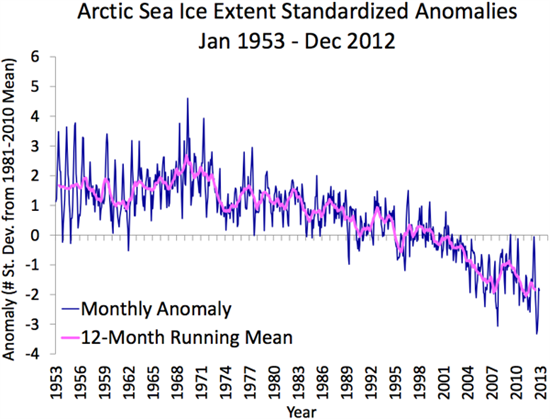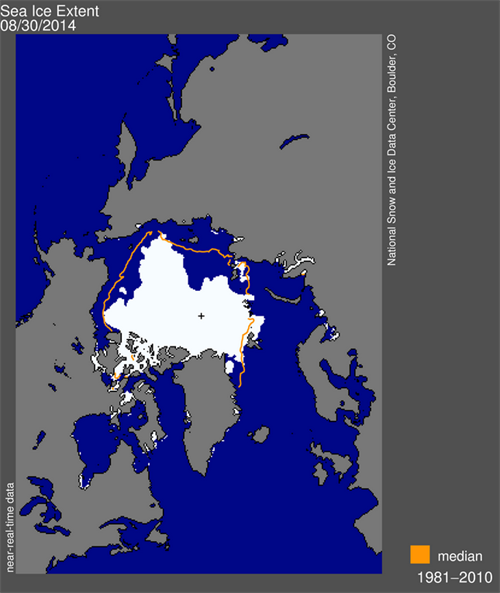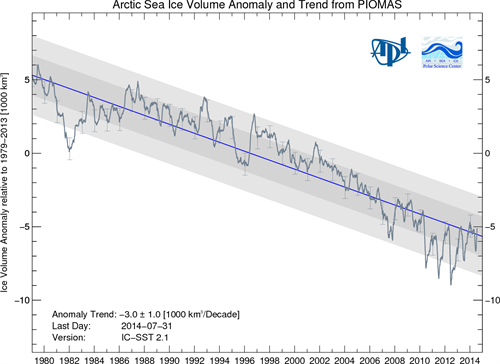The Mail on Sunday reports that Arctic summer ice is on the increase, disproving the “myth of Arctic meltdown”.
But the article, by journalist David Rose, acknowledges a declining trend in summer Arctic sea-ice. And scientists tell us the increase in ice is natural year-to-year variation.
Climate change is warming the Arctic, and scientists think it will make the region ice-free in summer at some point this century – points that despite the hyperbolic headline, the Mail on Sunday notes.
Ice gain or loss?
The Mail article reveals “how melt has slowed over ten years” using the graph below, showing Arctic sea ice extent from 2004 to 2014.
Arctic sea-ice extent 2004-2014. Mail on Sunday
However, taking a longer view shows a different picture. The graph below is from the NSIDC (National Snow and Ice Data Centre) at the University of Colorado, and plots data for the past 60 years.
The pink line shows the average area of Arctic sea-ice each year, compared with the long-term average – what’s called the sea ice ‘anomaly’.
While the amount of ice increases and decreases from year to year, the long term trend is clearly downwards.
Arctic sea-ice anomalies 1953-2013. NSIDC
In 2014, the amount of sea ice remains well below average.
The map (shown below) compares Arctic sea-ice extent from last weekend (30th August 2014) with the 30-year average, shown by the orange line.
Arctic sea-ice extent for 30th August 2014 (white areas) with long-term average (orange line) NSIDC
The latest IPCC report, which offers the most considered scientific view of how the climate is changing, states that “Arctic sea ice summer extent has decreased by between 9.4 to 13.6% per decade.”
The Mail article also suggests that Arctic sea-ice is thickening. It may be the case that the ice is thicker this year than last, but again, looking at more than a couple of years suggests that overall the volume of sea-ice is decreasing.
PIOMAS assessment of Arctic sea ice volume, from modelling based on measurements of the Arctic sea ice. Polar Science Center
Natural variability
It’s important to take a long-term view. We know that our climate fluctuates from year to year. This is known as natural variability, and looking at only a few years of data won’t give us the full picture.
With global temperatures, for example, scientists know that there is an overall warming trend. But this doesn’t mean that each year will be hotter than the last.
The same applies to Arctic sea-ice. The record lows in 2012 followed a warm summer, and the small recovery this year comes after a cool summer in the region.
As the Mail article acknowledges – some way below the headline – in the long-term the NSIDC data “still shows a decline.”
Man-made or natural?
Most recent Arctic ice loss is probably due to human activity, scientists think. But natural variability has probably also played a role. Dr Ed Hawkins, from the University of Reading, tells us:
“[V]ariability has probably contributed somewhat to the post-2000 steep declining trend, although the human-caused component still dominates.”
A paper published in Geophysical Research Letters found that up to half of the trend in Arctic sea-ice between 1979 and 2005 could be caused by natural variability.
Since 2005 sea-ice has declined very quickly. Another paper in journal Environmental Research Letters analysed data up to 2010 and suggested that between 5 and 30 per cent of declining Arctic sea ice could be explained by fluctuations in the Atlantic Ocean.
Ice free by mid-century?
So when might we see an ice-free Arctic in summer?
The Mail article also suggests that “many” have been warning of “imminent ice-free summers” in the Arctic.
This is a minority view amongst scientists, albeit one that received a lot of attention back in 2007 when a massive fall in the amount of sea ice shocked scientists.
The latest IPCC report, which is the closest thing to a mainstream view from scientists on the climate, suggests that ice-free summers in the Arctic likely wouldn’t happen until the middle of the century.
Professor Andrew Shepherd from the University of Leeds tell us:
“Arctic sea ice cover is expected to continue to decline, with the possibility of ice-free summers in the next 20-30 years.”
Of course, Arctic sea-ice isn’t the only indication that the Arctic is warming up. As Carbon Brief reported last week, new research has shown that ice loss from Greenland has doubled since 2009.





